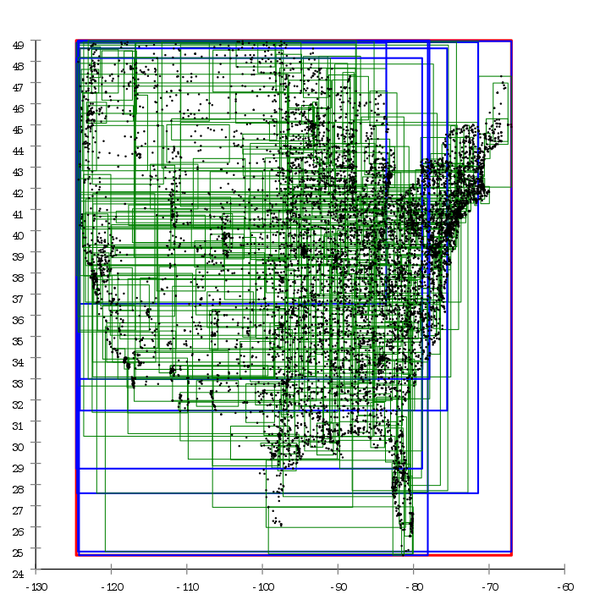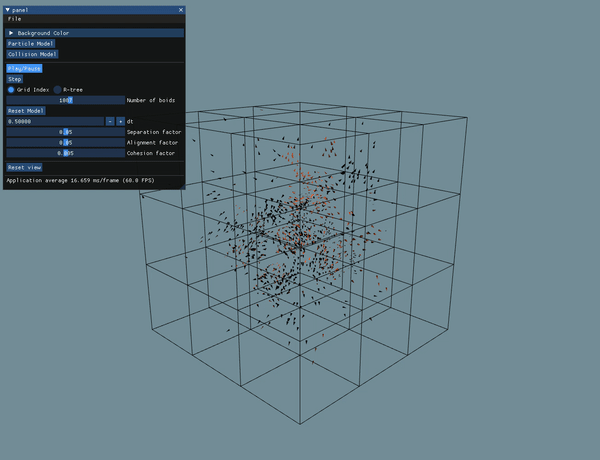This is the fifth assignment of CPSC 687 (Animation) course held in winter 2022 semester at the University of Calgary. In this assignment, I implemented flocks simulation based on the "Flocks, Herds, and Schools: A Distributed Behavioral Model" article by Craig W. Reynolds.
Each Particle has these attributes.
position(vec3f)Velocity(vec3f)initialPosition(vec3f) -> useful for resetting the modelisBarrier(bool) -> used this attribute to make a boid stationary that works as a barrier.
And some methods.
-
applyForce(vec3f force, float dt)This function applies force on the particle by changing its velocity based on its mass.
-
applyVelocity(float dt)This function moves the particle based on its velocity.
-
applyVelocityLimit(float maxSpeed)This function scales the velocity down to the max speed.
each model has a vector of particles and a set of attributes related to the model
std::vector<std::shared_ptr<Particle>> particlesbounds = 30The limits of cube (-30 to +30)velocityLimit = 3turnFactor = 0.2The acceleration of each axis speedseparationRadius = 2separationAngle = M_PI * (1.f/2.f)separationConstant = 1alignmentRadius = 4alignmentAngle = M_PIalignmentConstant = 1cohesionRadius = 3cohesionAngle = M_PIcohesionConstant = 1
All three constants are controllable via GUI.
Step function, moves all particles on step in the time. This function is like below pseudocode.
virtual void step(float dt) {
float maxRadius = std::max(separationRadius, std::max(alignmentRadius, cohesionRadius));
SpatialStructure spatialStructure = BoostRTree(particles);
for (size_t i = 0; i < particles.size(); i++) {
auto &p = particles[i];
neighbors = spatialStructure.getNeighbours(p.position, maxRadius);
for (auto &j: neighbors) {
if (i == j) {
continue;
}
Particle neighbor = particles[j];
auto deltaPos = p.position - neighbor.position;
auto distance = glm::length(deltaPos);
auto alpha = glm::dot(deltaPos, p.velocity);
if (distance < separationRadius && alpha > cos(separationRadius)) {
p.applyForce(calculateSeparationForce(p, neighbor), dt);
}
if (distance < alignmentRadius && alpha > cos(alignmentAngle)) {
p.applyForce(calculateAlignmentForce(p, neighbor), dt);
}
if (distance < cohesionRadius && alpha > cos(cohesionAngle)) {
p.applyForce(calculateCohesionForce(p, neighbor), dt);
}
}
applyColision(p);
p.applyVelocityLimit(velocityLimit);
}
for (auto &p : particles) {
p.applyVelocity(dt);
}
};In the collision part, it will check if the particle is out of each bound or not. If it is, a constant acceleration
(turnFactor) will be applied on that axis of velocity.
Twe different spatial structures has been implemented.
Grid indexing is the simple mapping of points to the cubes with edge of maximum radius among separation, alignment and cohesion.
The class MamziIndex is for this type of spatial indexing.
It has a std::map<std::vector<int>, std::vector<int>> variable named spatialMap which contains a vector of particle indices for each cube.
And each cube is shown by its minimum vertex (a particle with position xyz will be in the cube of {floor(x/radius), floor(y/radius), floor(z/radius)}).
R-tree is a data structure for spatial indexing created by Antonin Guttman, introduced in the "R-Trees: A Dynamic Index Structure for Spatial Searching" article. I used the boost library for implementing this structure. R-tree will divide the space based on minimum bounding rectangles.
Sample visualization of r-tree by Chire.
There is a collision model implemented in the GUI, that has a queue of boid going toward a barrier boid in the center.
The result was not satisfying for me, but I didn't remove it from the code. It simply has the same step function, but for other boids only the separation force will be applied in collision with the barrier boid in the center.
Same as the mass-spring assignment, there are two buttons on the top for choosing the model.
The particle model is a model of generating boids at random position and start to move them via the rules.
After that, we have play/pause button and step button.
Bellow those buttons, user can choose which indexing they want to use, simple grid indexing or r-tree.
Based on theories the R-tree model should be faster, but in my code, both models was handling about 1200 boids at most. please use both models for competition if it's possible :D
Under those options, we have the number of boids. Any time the number of boids are changing, the model should be reset to see the effect.
And under reset button, we have different coefficients of the models. They can be changed in real-time.
sudo apt install cmake build-essential libboost-dev
I used boost library for including R-tree as a Spatial indexing structure.
cmake -H. -Bbuild -DCMAKE_BUILD_TYPE=Release
cmake --build build
build/simple


